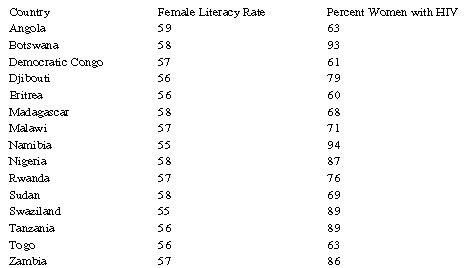Essentials of Social Statistics for a Diverse Society
Second Edition
Study Questions
The following set of questions utilizes data from the Population Reference Bureau (PRB) on the relationship between women's literacy and the prevalence of HIV in Sub-Saharan Africa. Using the PRB's Data Finder tool, data were assembled for 15 countries in Sub-Saharan Africa through the year 2004 and are shown below.

- A researcher advances the hypothesis that women in countries with lower female literacy rates tend to see a greater percentage of the female population infected with HIV. What is the independent variable here? What is the dependent variable here?
- Using the above data, a scatter diagram was constructed. Very generally, what does this scatter diagram indicate about the relationship between female literacy rates and the percentage of females with HIV? Does the relationship appear to be negative, positive, or neither? Interpret this relationship (assuming it was the true relationship in the population).

- Several statistics were calculated from these data for both the independent and the dependent variables. Identify (i.e., name) the statistic summarizing the independent and dependent variables below.

- Without doing any calculations, you should be able to identify the direction of the relationship between female literacy rates and the percentage of females with HIV from the statistics provided in Question #3. What is the direction of this relationship?
- Using the statistics provided in Question #3, calculate both the Y-intercept and slope coefficient for the regression equation. Once you arrive at these quantities, write down the full regression equation in proper notation and provide a one sentence interpretation of the slope coefficient.
- According to the regression equation that you calculated above, what is the predicted percentage of women with HIV in a hypothetical country where the female literacy rate is equal to zero?
- Using the statistics provided in Question #3, calculate the value of Pearson's correlation coefficient, r, and provide a one sentence interpretation of this quantity. Likewise, calculate the value of the coefficient of determination, r2, and provide a one sentence interpretation of this quantity.
- According to the above regression equation, what percentage of variation in the dependent variable - the percentage of females with HIV- is explained by only considering the independent variable - female literacy rates? What is the statistical term for this quantity as it was referred to in Chapter 13 of your textbook. What percentage of variation remains unexplained?
- For each of the 15 countries considered in this analysis, what is the predicted value for the percentage of women with HIV? Identify the five countries with the largest residuals? Pick one of these countries and interpret its residual in statistical terms.
